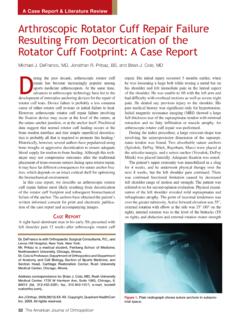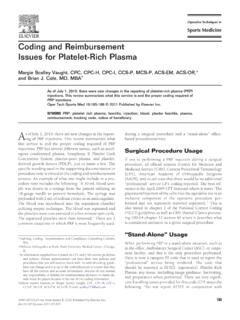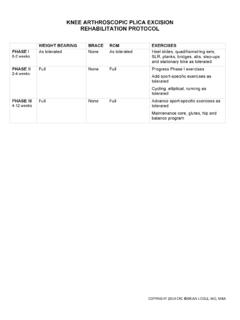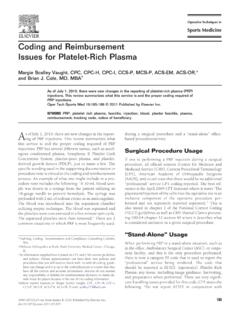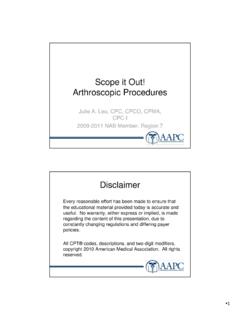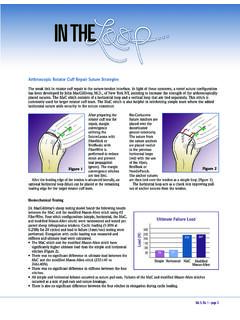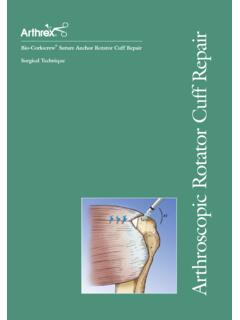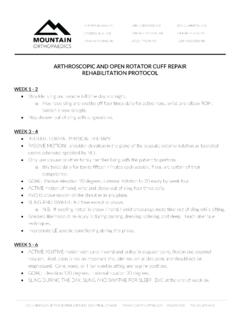Transcription of Arthroscopic Rotator Cuff Repairs: An Anatomic and ...
1 Current ConceptsArthroscopic Rotator cuff Repairs: An Anatomic and Biomechanical Rationale for DifferentSuture-Anchor repair ConfigurationsBrian J. Cole, , Neal S. ElAttrache, , and Ammar Anbari, :The goal of Rotator cuff repairs is to achieve high initial fixation strength, minimize gapformation, maintain mechanical stability under cyclic loading, and optimize the biology of thetendon-bone interface until the cuff heals biologically to the bone. We have seen an evolution in ourapproaches to fixing Rotator cuff tears from open to mini-open to all Arthroscopic . In our arthroscopictechniques, we have also seen a change in the types of anchors and sutures we use and our repairtechniques including an evolution in techniques that include single row, double row, and, mostrecently, transosseous equivalent fixation.
2 Single-row repairs are least successful in restoring thefootprint of the Rotator cuff and are most susceptible to gap formation. Double-row repairs have animproved load to failure and minimal gap formation. Transosseous equivalent repairs have thehighest ultimate load and resistance to shear and rotational forces and the lowest gap formation. Thisreview will discuss the anatomy and biomechanics of a normal Rotator cuff , the biomechanical factorsthat play a role in Rotator cuff repairs, the initial fixation repair mechanics, and finally propose analgorithm for Rotator cuff fixation based on tissue quality and tear Words:Rotatorcuff Footprint Single row Double row Transosseous equivalent goal of Rotator cuff repairs is to achieve highinitial fixation strength, minimize gap formation,maintain mechanical stability under cyclic loading,and optimize the biology of the tendon-bone healingzone until the cuff heals biologically to the bone.
3 Weknow from outcome studies that healed cuffs havebetter function. Ultimately, a successful repair shouldlead to the elimination of pain, improved strength, andrange of the years, we have seen anevolution in our approaches to fixing Rotator cuff tearsfrom open to mini-open to all Arthroscopic . In our ar-throscopic techniques, not only have we changed thetypes of anchors and sutures implemented but also theprocedures themselves including single-row, double-row, and, most recently, transosseous equivalent review will discuss the anatomy and bio-mechanics of a normal Rotator cuff , the biomechanicalfactors that play a role in Rotator cuff repairs, and theinitial fixation repair mechanics and finally propose analgorithm for Rotator cuff fixation based on tissue qualityand tear FOR CHANGE IN REPAIRTECHNIQUESR otator cuff repair techniques have evolved overthe past decade because of the emerging reports onFrom the Department of Orthopedics and Anatomy and CellBiology, Rush University Medical Center ( ), Chicago, Illi-nois.
4 Kerlan Jobe Orthopaedic Clinic ( ), Los Angeles, Cal-ifornia; and Norwich Orthopedic Group ( ), North Franklin,Connecticut, authors report no conflict of correspondence and requests for reprints to Brian , , , Department of Orthopedics and Anatomyand Cell Biology, Rush University Medical Center, 1725 WHarrison, Suite 1063, Chicago, IL 60612, : 2007 by the Arthroscopy Association of North America0749-8063/07/2306-6628$ : The Journal of Arthroscopic and Related Surgery, Vol 23, No 6 (June), 2007: pp 662-669failure and retear of technical dif-ficulties and steep learning curves, our early arthro-scopic repair techniques failed to restore the anatomicfootprint of the Rotator cuff leading to incomplete andbiomechanically weaker surgeons be-came more comfortable in their Arthroscopic tech-niques, the next goal was to replicate the anatomicrestoration of the footprint seen in open transosseous techniques can capture a widersection of the Rotator cuff footprint leading to a moresecure OF repair FAILURESE arly Rotator cuff failures and retears are caused bya number of potential causes including anchors pullingout of the bone, suture failure, and knot stronger suture materials were introduced.
5 Failuresoccurred more often at the suture-tendon interfacewith the sutures pulling out of poor quality tissuebefore it could heal to the bone. In addition, some ofthe stronger suture configurations such as the Mason-Allen configuration,26which is often used in opentechniques, are very difficult to replicate arthroscopi-cally, and our simple and mattress sutures alone maynot be sufficient to maintain the Rotator cuff tendon toits boney bed until it heals. In reality, biomechanicalcauses of retears are often multifactorial including acombination of anchor and suture-tendon Anatomic Rotator CUFFFOOTPRINTR ecent Anatomic studies have clearly described theanatomy of the supraspinatus footprint on the anterior-posterior dimension wasmeasured to be about 25 mm and the medial-lateraldimension to be 14 mm.
6 This calculates to a total of350 mm2. This is an important consideration becauseachieving an Anatomic repair requires restoration ofthe cuff footprint. This footprint should be thought ofas the maximum 2-dimensional healing zone. Thegreater the extent to which a given repair covers andsecures tendon over the healing zone, the greater thechance for tendon-bone healing. Conversely, tech-niques that secure less tendon over a smaller area ofthis healing zone should be expected to have higherfailure rates. Some Rotator cuff tears may not be ame-nable to complete closure and reattachment to theanatomic footprint, as is occasionally the case in mas-sive chronic retracted tears. repair strategies for thesesituations will be discussed Rotator cuff MECHANICSWhen considering which fixation techniques to use,one has to first examine the in vivo forces experiencedby the normal Rotator cuff muscles before they studies have attempted to shed light on thisconcept.
7 A study by Hughes and An28used a Cybexmachine (Lumex, New York, NY) to measure therotator cuff forces during a maximal isometric exer-tion. The supraspinatus forces were greatest with thearm abducted and externally rotated and measured 175N. The infraspinatus forces were greatest with the armadducted and externally rotated and measured 909 study by Chang et the muscleforces in the shoulder in internal rotation by using aMonte Carlo simulation. This method uses a random-number generator and is used to simulate variability inmuscle moment arms allowing the estimation of mus-cle forces. The subscapularis and pectoralis majorwere the two major internal rotators, and although thesupraspinatus force was 190 N, the infraspinatus wasonly 55 , a study by Wakabayashi et finite element analysis and magneticresonance imaging (MRI) to study the geometry ofand the stress on the supraspinatus tendon.
8 Resultsof the study showed that the supraspinatus experi-enced the highest stress on the articular side near itsinsertion. Because the shoulder is progressively ab-ducted, the stress shifted laterally toward the , a study by Juul-Kristensen et of 20 healthy shoulders to determine the anthro-pometric and moment arms of the supraspinatus andinfraspinatus. The supraspinatus had a maximal forceof 353 N and Nm of torque, and the infraspinatushad a maximal force of 665 N and Nm of the results of these studies vary and theirmeasurement methods differ, they share a commonconclusion that shoulder rotation and abduction/ad-duction has an effect on the forces experienced by thesupraspinatus and the infraspinatus and these forcesare not static. The supraspinatus forces ranged from43 to 350 N based on shoulder position and the in-fraspinatus forces ranged between 55 and 900 , these forces are more concentrated lat-erally at the insertion of the muscles on the greater663 Arthroscopic Rotator cuff repair tuberosity and moved more laterally with increasedabduction.
9 These conclusions may theoretically sup-port medial row fixation in which the tendon experi-ences the highest amount of cuff FUNCTIONALMORPHOLOGYIt is also important to determine differences in stressdistribution within the Rotator cuff tendon itself. Itoiet the tensile properties of the supraspi-natus tendon using human cadaveric shoulders. Theydivided the tendon into 3 strips (anterior, middle, andposterior). The modulus of elasticity was greatest inthe anterior strip along with the ultimate load andstress. They concluded that the anterior third of thesupraspinatus was the strongest portion of the muscletendon and seemed to perform the strongest role in another study by Fallon et al.,33it was notedthat the medial portion of the supraspinatus tendoncontained parallel fascicles without interdigitationand some convergence laterally.
10 On the other hand,the tendon attachment contained more disorganizedfascicles with a basket-weave pattern. The impor-tance of these 2 studies is that fixation that takesadvantage of the more uniform and more organizedtissue seen medially in combination with more dis-organized pattern laterally may best resist suture-tendon failure. In addition, repairs should wheneverpossible include the most anterior aspect of OF CHRONICITY IN ROTATORCUFF REPAIRSThe role that time plays on the quality of rotatorcuff tissue has been the subject of a number of study by Gimbel et a rat model showed thatthe tension experienced by the repaired cuff tendonincreased with delayed repairs. Similarly, Gerberet that in a sheep model, early repairs hadthe lowest forces and that chronic Rotator cuff tearsshowed increasing and irreversible changes includingfatty infiltration.
